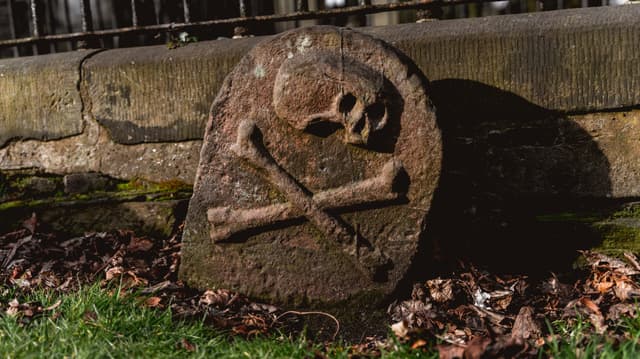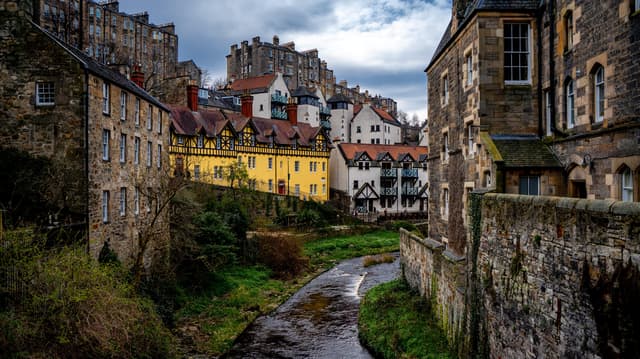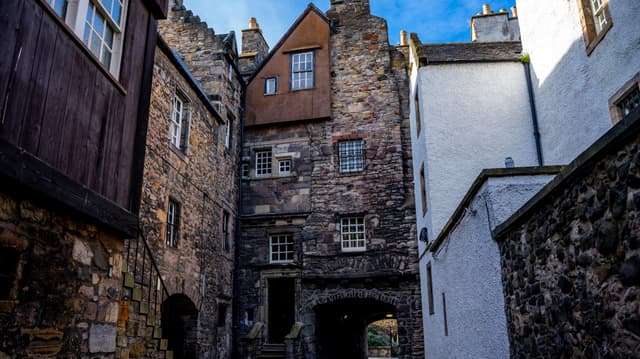The Alternative Guide to Edinburgh Map
Save for Later
Share
The Alternative Guide to Edinburgh Map
The Alternative Guide
Welcome to The Alternative Guide to Edinburgh Map featuring the 20 best unusual, dark and witchy things to do. My tailored interactive map is perfect for when you are out on your travels, including my full city guide, photographs and location details all in one place.
Click to discover Edinburgh through an alternative lens as we step off the beaten track and unearth hidden gems and curiosities that are often left undiscovered unless you know a local.
Featuring 20 unexpected, quirky and one-of-a-kind locations, I guarantee the guide will make for a memorable yet extraordinary experience to complete your visit to Scotland’s capital City.
In my interactive map I reveal my black book of favourite places to visit including detailed accounts of each location, historic tales and of course my top travel tips.
This guide was made to inspire you to wander from the usual tourist path, whilst providing a comprehensive guide to inspire fellow off-beat adventurers who intend to visit Edinburgh!
Please feel free to get in touch if you have any questions. Thanks, Vicky
@thealternativeguide_
Updated ago
13
Share
Hotel recommendation

House of Gods Hotel
@thealternativeguide
A hotel which is dark, mystical and oozes with decadence, House of Gods is an unforgettable boutique experience, which makes for the perfect stay whilst visiting Edinburgh.
They pride themselves on rule breaking and believe that ‘beige is blasphemy’; curating rooms filled with extravagance, hedonistic style and lashings of grandeur.
On arrival, the building which is situated on Edinburgh’s well known Cowgate, looks quite common place with only a red neon sign illuminating the way. However, as you cross the shadowy threshold you are instantly immersed into their moody world of ‘unapologetic extravagance’.
We opted to stay in one of their ‘cosy cabin’ rooms which perfectly reflect the exotic compartments of the Orient Express. They are brimming with personality from the wine-coloured upholstered walls, to a hidden TV mirror, hand built cocktail bar and herringbone floors. The low-lit quirky rooms have been extremely well designed to cleverly utilise the compact space, making them perfect for the solo traveller or a one-night stay. Although, if your budget allows, or you travel with a lot of luggage (as I do), I recommend considering their Versailles inspired classic room which offers a little more space and a show stopping four-poster bed. If you really want to treat yourself then opt for their luxurious suite of wild excess with its very own copper freestanding bathtub!
We also received complimentary access to their full butler service by booking directly through the hotel’s website. Within your room you can press the buzzer for two free glasses of prosecco, bedtime milk and cookies and, upon awakening a breakfast hamper, all delivered directly to your door. Plus, a £10 Cocktail tab to spend at their in-house bar - Lilith's Lounge, which has a rock ‘n’ roll inspired drinks menu. This type of personalised service is a particularly unique touch making for an unforgettable getaway. The hotel also offers even more lavish VIP riders including ‘Treat me like I’m famous’, which can be added when booking, to make for an extra special visit.
Dramatic, opulent, and made for misbehaviour, a stay at House of Gods is a truly immersive experience which will leave you feeling like a bona fide rock star!
Add to
Details
Things to do

Greyfriars Kirkyard
@thealternativeguide
Situated on the edge of Edinburgh’s Old Town, the eerie yet beautiful Greyfriars Kirkyard dates back to the 1600’s and is said to be one of the most haunted graveyards in the entire world! It’s renowned for being the final resting place for many of Edinburgh’s most notorious figures, with one of the most famous being a four-legged fellow named Bobby (but more on that later).
The site is filled with hundreds of fascinating headstones and macabre tombs, but, for your first stop I’d recommend a visit to the black domed mausoleum of George Mackenzie, which can be found on the southern side of the graveyard.
In the 17th Century George Mackenzie became Lord Advocate and soon gained notoriety for being one of the most brutal and vicious persecutors of Covenanters (protestants who resisted the King’s control of the Church) there was. One of his most merciless actions involved imprisoning and torturing 100’s of Scots in a makeshift ‘Covenanters prison’, which can still be seen through the locked iron gates in the Southwest corner of the graveyard. Most of the prisoners who were held here unfortunately died during the traumatic experience and are said to be buried in a mass grave in the kirkyard. Due to the torturous deeds he exacted across the city he was nicknamed George "Bluidy" Mackenzie and was thought to have been responsible for more than 15,000 deaths during a period in history known as ‘The Killing Time’.
In 1998 a homeless man decided to take shelter in the mausoleum, causing the floor to collapse, which in turn unearthed the bone pit releasing the supposed poltergeist of Mackenzie himself! Since then, the burial site has been steeped in ghost stories, with hundreds of reports of paranormal activity surrounding the tomb with visitors being bitten, scratched, cut and bruised with many experiencing a feeling of cold rush through their body. It also probably didn’t help bring peace to Mackenzie, when a few years later two teenage boys broke into the tomb and cut the head from the mummified corpse and were reported to have been seen playing football with the skull in Greyfriars – you couldn’t make this stuff up could you?
One of the best ways to learn more about the history surrounding this unnerving chain of events is to book one of Edinburgh’s spooky ghost tours.
Aside from the ghost stories, the graveyard is filled with numerous skull carvings, making it a must visit if only for this reason! One which particularly gained my attention was that of the anatomist ‘James Borthwick of Stow’, which is located on the Eastern end of the ‘Kirk’ (which is old Scottish for Church). The master surgeon’s tombstone showcases a full-length skeleton who looks to be dancing whilst holding ‘the book of life’ representing the good deeds of the departed, as well as a weathered scythe connoting the harvesting of souls. Also, if you look closely at the side panels you will see various surgical instruments depicting his profession.
Tip: Make sure to look out for the Mortsafes (the graves which had bars put over them to stop grave robbers from snatching the bodies back in the day).
Add to
Details

The Water of Leith & Dean Village
@thealternativeguide
If you are looking to escape the city centre and find a few historic gems along the way, then I’d highly recommend a ramble along the Water of Leith Walkway.
Situated a short walk from the hustle and bustle of Edinburgh’s busy streets, the snaking river path takes you through an astonishing urban wildlife site providing ample opportunities to see many different species of birds.
Join the path from Dean Bridge, with your first stop being a little turreted home located at 12 Miller Row. The medieval style architecture, which this small establishment showcases, instantly made it one of my favourite buildings to photograph during my visit.
Carry on slightly further West to be transported back in time as you enter the picturesque, cobbled streets of Dean Village. One of Edinburgh’s oldest known villages, it was once the former home to many grain mills, which were powered by the water from the river and it still has numerous millstones as a reminder of its history. Firstly, stop at Bell’s Brae Bridge to capture one viewpoint of this sleepy suburb’s quaint architecture, which lines both sides of the water and then head along Damside to another wonderful vantage point from the Water of Leith Walkway footbridge. From this angle you can see the iconic red sandstone building known as Well Court, which was built in the 1880s to house the local mill workers.
Dean Village also has its own fascinating cemetery and modern art gallery to check out, which are both located moments away from the riverside path.
Tip: If you have time continue your walk along the river where you will eventually reach Colinton Tunnel (around a 1.5hr walk), which is an old railway tunnel that has been transformed into Scotland’s largest living mural.
Add to
Details

St Cuthbert's Kirkyard
@thealternativeguide
Nestled in the shadows of Edinburgh Castle, St Cuthbert’s Graveyard might easily get overlooked, but if you like headstone symbolism (particularly skulls and crossbones) this graveyard is one you have to visit!
St Cuthbert’s is one of the oldest sites of worship in the whole of Edinburgh and is a place of peace in the heart of the busy city. The extensive churchyard is fascinating to wander around hosting some of the most interesting stones I’ve ever seen. Make your way to the south corner of the kirkyard, to discover many crumbling mausoleums, weathered slabs and ‘memento mori’ carvings in every direction you look. One stone that particularly caught my eye was attributed to David Grey and included a winged angel paired with skulls, hourglasses and scythes in a beautiful design.
If you look towards the western side of the burial ground, you will see the sandstone watchtower which was erected in the 1800’s, to try and keep grave robbers at bay. During this era, body snatching was rife due to a decrease in executions taking place and an increase in students wanting to learn about medical science and therefore needing cadavers to dissect. The demands were so high for bodies, universities would pay handsomely, making grave robbing seem somewhat appealing! Body snatchers would lurk around certain graveyards waiting until nightfall to dig up freshly buried corpses, to steal the body before selling it on to medical professionals. Two of the most well know names from this time were Burke and Hare, individuals who started out body snatching, before that practise became more difficult with the installation of watchtowers and patrols. Undeterred, they then decided to go on a murder spree taking the lives of 16 innocent people, who all suspiciously ended up appearing in the anatomy lectures of Doctor Robert Knox, who worked as a professor at the University of Edinburgh.
Tip: Look out for George Meikle Kemp’s grave, who was the self-taught architect who designed the beautiful gothic treasure that is the Scott Monument.
Add to
Details

Bakehouse Close
@thealternativeguide
Bakehouse Close is a picturesque well-preserved passageway located at the eastern end of the Royal Mile and it’s one which also has many ties to the Old Town’s more sordid past. In the 1700s a document called the ‘Ranger’s Impartial List’ was created for gentlemen visiting the city wanting to procure a lady of the night. It listed different criteria for each woman and where to locate them, with one such place being ‘The Cock and Trumpet Pub’ which was located in this very close. You can still find the Cock and Trumpet emblem above the doorway of the courtyard at Archeson House, which is now the home of the Edinburgh World Heritage Organisation.
Add to
Details

Buy to unlock full guide
Access all the local insights and recommendations from @thealternativeguide when you purchase this guide.
5.0 (1 Ratings & Reviews)
"This alternative guide is so helpful and comprehensive. It features so many amazing hidden spots off the beaten track and is perfect for people like me who seek out the darker, unusual and quirky thin..."
Read more
Jan 2025
ABOUT THE AUTHOR
The Alternative Guide
Hi there, I'm Vicky founder of The Alternative Guide.
Every time I travel to a new city I make a list of unusual places, quirky stores, speciality coffee shops, dark museums, independent eateries, one-off street art and any other off the beaten track places I can manage to find.
I put www.thealternativeguide.com together to provide an alternative lens on some of the major cities across the world, encourage support for local independents and share my black book of favourite places to visit.
Hopefully this will inspire you to stray from the usual tourist path and at the same time provide a comprehensive guide for fellow off-beat adventurers when travelling to a new city.
Thanks for reading and feel free to reach out to me with any questions.
IG: @thealternativeguide_
What's included
Digital Map
Fully interactive, digital map for finding places nearby
20 places
20 hand-picked places with notes from the creator
DESTINATION(S) COVERED
Edinburgh, UK
FOCUSES AND THEMES
Boutique
History
Slow Travel
Photography
Architecture
People & Culture
Format
Guide
Guides typically include detailed information and how-to’s about a destination as well as suggested places to try.
COMMON QUESTIONS
What is Thatch?
Thatch is an online marketplace that provides instant access to thousands of vetted local experts and premium travel guides - making it the easiest and most affordable way to take high quality trips with less stress.
For travel creators (tastemakers, travel advisors, influencers and local experts) Thatch makes it easy to curate, publish, and sell digital travel guides, itineraries and personalized planning services.
What if I’m not satisfied with my purchase?
How do I access my purchased guides?
Can I access my guide offline?
How often are guides updated?
Can I request a personalized guide or itinerary?
Can I sell my own travel guides and itineraries?
Save for Later
Share